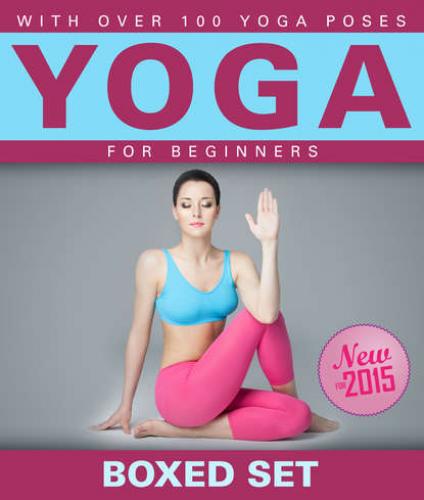Table of Contents
Yoga for Beginners: Basic Yoga Guide
Chapter 1. The Basic Principles of Yoga
Chapter 2. How to Pick The Right Time and Place For Practice
Chapter 3. Right Relaxation Techniques For Practicing Yoga
Chapter 4. How to Perform The Right Yoga Breathing
Chapter 5. How to Perform Yoga Meditation Properly
Chapter 5. Yoga Exercises to Practice
Chapter 6. How to Apply The Right Yoga Diet
Chapter 7. How to Dress Properly
Chapter 8. How to Select The Right Yoga Mat
Chapter 9. Essential Tips For Beginners
Book 1 : 11 Simple Yoga Poses For Beginners
Book 2: The Daily Yoga Ritual Lifestyle by Alecandra Baldec
Yoga For The Beginner: The Starter Guide
Learning The Basics Yoga Practices
By: Andrew Z. Maitland
Chapter 1- Yoga- A Brief History
In the world today many fitness enthusiasts have turned to yoga as a workout program to help them build strength, burn body fat, increase flexibility and overall health. Many people don't realize that yoga has been around for centuries and has been used by many world leaders. Yoga originated in India. Yoga has both health and spiritual benefits that come from various religious practices over centuries.
Despite the long history, yoga has continually changed its methods over the centuries. In the initial years, yoga focused on basic physical postures and breathing patterns; as the centuries progressed yoga has become more advanced with a large amount of styles, poses, and methods. The practice of Yoga has expanded over the last several decades. Below is a brief history of the activity of yoga.
Early History
Research has indicated that yoga was first started back in 3000 SC. However, many historians believe that yoga might have been started back in the Stone Age era. Many historical carvings, from late centuries, show ancient people using yoga moves. Many historians don't know how the people were able to learn such poses in the Stone Age. Yoga originally was a meditation method that was used by people to encourage a strong mind and body. In its course of history yoga has been broken down into 4 periods. The periods of yoga start with the Vedic Period followed by the Pre Classical, Classical, and Post Classical. All these periods play a large role in the evolution of yoga.
Vedic Period of Yoga
The sacred scripture of Vedas is a record of yoga. Vedas is a Brahmanism scripture that is very similar to Hinduism. The Vedas started as song hymns that discuss the power of praise and using divine power. The Vedas used religious ceremonies, rituals, and services which made it called Vedic Yoga. Vedic people began teaching this yoga by following scriptures and using different moving patterns to encourage the practice.
Pre Classical Yoga
Pre Classical yoga began with the creation of the Upanishads. The Upanishads was a group similar to the Vedas that continued the teachings of the Vedas. The Upanishads created 3 main subjects that were inspired and revaluated by them. The 3 subjects are; the ultimate reality, which is also known as Brahman, the transcendental self also known as atman, and the relationship between the two.
The Upanishads felt that Yoga creations were not only shared from Hinduism but also shares with Buddhism. During 600 B.C. the legend Buddha started teaching Buddhism. Buddhism preaches about Meditation and practicing physical yoga postures. The first Buddhist to study the activity of yoga was Siddhartha Gautama. During this time frame yoga was still growing with the installation of different poses and methods.
Classical Yoga
The Yoga Sutras was a document that created the classical period of yoga. This document stressed the importance of yoga postures and was believed to be written in 200 AC by Patanjali. The document was written to help educate people about the proper techniques of yoga. Techniques, posture, and breathing techniques were explained to help people performing the activity.
The document was meant to help people understand how to perform the postures and positions. In the past many people would make up their own postures that wouldn't benefit them in anyway. A lot of people were also teaching incorrect postures which created a chain reaction. There was also a very large population of people that were not breathing correctly during the yoga sessions, which just led to more confusion amongst yoga enthusiasts.
The Yoga Sutras created a method called Eight Limbs of Classical Yoga. The eight limbs are meanings for people. The 8 limbs are Yama, Niyama, Asanas, Pranayama, Pratyahara, Dharana, Dhyana, and Samadhi. During the classical time of yoga the instructors focused on getting stronger by using the physical posture techniques along with working on meditation skills to build the body’s confidence and spirit; the term “your body is a temple" was used.
The yogi's wanted to make their bodies immortal. The good part about the document was that yoga instructors now had a good blueprint for what they wanted to do as far as teaching. The document also started making more people interested in yoga because of the benefits that they could achieve from the practice.
Post Classical Yoga
As the years went on Yoga became more popular and was founded by the various countries during the 19th century. It was first studied by students and medical professionals as part of Eastern Philosophy. Yoga inspired people to be healthy in the late 1920's and this later created a generation of people that became enthusiastic about fitness. Many new people started to become yoga instructors which led to new yoga workout styles and methods. Instructors started to come up with different poses and workout routines in the 1950's and 60's. The styles still kept the basic yoga principals, but expanded on them making it more beneficial.
Different styles of yoga began to be added in books and television. The media started to get more interested in this activity. Eventually more people from across the world
